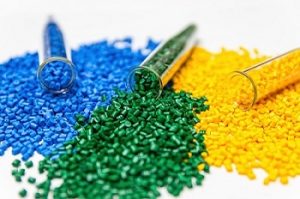When the Wright brothers built the first flying machine, they used wood and fabric as their primary aircraft materials. Though these materials were an excellent starting point, their weight and flammability weren’t ideal. The search for better aerospace materials has continued ever since.
In 1970, plane plastics revolutionized the aviation industry by reducing aircraft weight and improving fuel efficiency. Today, plastics are everywhere in aerospace, with commercial and military aircraft using the material in various sections of their planes. Everything from navigational system components and structural elements to interior parts uses different plastics.
What makes manufacturers choose such materials? The answer lies in their material properties and the diversity of resins available today.
Comparing Plastic and Metal Parts for the Aerospace Industry
Plastic is a dominant material across industries today, competing on the same level as metals like steel and aluminum. Because of plastic’s versatility, aircraft builders can incorporate them into many projects. Using plastic for aircraft construction has numerous positive impacts, both on the design of the aircraft and the industry as a whole.
Reduced Costs
Aerospace manufacturers always seek to identify ways to improve designs while reducing costs. Many raw plastic materials are more affordable than metal. Likewise, working with plastic is simpler; injection molding is much faster and more repeatable than metal machining. Plastics make for a cost-effective solution as a raw material and during production. In challenging supply environments, it’s no surprise that many manufacturers prefer using aerospace plastics to improve the cost-effectiveness of each project.
Improved Productivity
Working with metals in manufacturing requires machining and extensive finishing. These additional processes slow down production time and increase turnarounds. Further, CNC machines have limitations on the number of parts they can shape and cut per day. This constraint makes achieving a high production rate difficult. On the other hand, plastic through injection molding ensures accuracy and speed, resulting in an ample supply and availability of crucial aerospace parts.
Unmatched Durability and Thermal Stability
Metal parts are often subject to the effects of the elements and extreme working environments, which can lead to corrosion and deterioration. Such points of failure mean more maintenance and expenses. With plastics, some resins remain exceedingly durable even in high-stress environments. Airplane plastics must withstand severe physical conditions, just as metal parts do. Even some of today’s lightweight aircraft, such as gliders, have canopies in plastic instead of glass. Today’s premier aerospace plastic parts offer one of the best ways to navigate these challenges.
Safety and Fire Resistance
Suitable plastic materials are safer for aircraft, especially when selecting flame-resistant resins. There’s a reason an aircraft interior has plastics in many places, such as windows or overhead bins. The resins used for these items are more fire resistant, slowing the spread and creating more time for safe evacuations. They help prevent emergencies due to material failures.
Different Types of Plastic the Aerospace Industry Uses
As mentioned, the popularity of plastic airplane materials is tied, in part, to the wide range of plastics available today. Choosing the appropriate material for any application is fundamental to a project’s success — and there are many types to choose from.
Polyetheretherketone (PEEK)
Manufacturers prefer this advanced aerospace polymer because of its durability and environmental resistance. It can operate optimally at very low temperatures while remaining exceedingly resistant to high-pressure steam and water. It’s the perfect material for use in heavy-duty scenarios, such as within valves for water or gas seals. Polyetheretherketone is also excellent for electrical elements such as connectors and insulators.
Polychlorotrifluoroethylene (PCTFE)
This material is similar to PEEK in terms of resistance to corrosion and temperature extremes. Primarily, this polymer is ideal for setting up a barrier in mechanical applications. This material is substantially featured in manufacturing seals, valves, impellers, and valve gaskets. These are all essential components within an aircraft’s hydraulic and propulsion systems.
Thermosetting Polyimide
This polyimide is a polymer used as plastic insulators for nuts and bolts to prevent the transmission of unwanted charges across different internal components. As a robust insulating material, it rejects electrical charges instead of carrying them to parts that could be sensitive to electrical damage.
Polytetrafluoroethylene (PTFE)
Better known as Teflon, PTFE features are mainly used to wrap wires. Aerospace engineering requires wires, tubes, and other lines throughout an aircraft. This plastic offers a layer of protection that doesn’t rust and won’t ignite.
Polyamide-imide (PAI)
The PAI is probably the aircraft plastic that has replaced metal most frequently in the aerospace industry. It boasts a high heat resistance of up to 500 degrees Fahrenheit. If this type of plastic catches fire, it won’t release smoke, making it critical for safe evacuation processes.
Ultra-high-molecular-weight polyethylene (UHMWPE)
This aerospace plastic is incredibly lightweight and durable. Compared to steel products, this plastic is also resistant to external elements, so you’ll find it on an aircraft’s wings and wingtips.
Polycarbonate (PC)
Polycarbonate is a popular plastic across industries, not just aerospace. Its high durability and ability to make PCs with various degrees of transparency give it many applications, such as for lights. The interior, non-pressurized window panels in most airplanes are made of PC.
Polyethylene (PE)
Polyethylene does not absorb moisture or humidity easily and resists degrading under chemical exposure. Like other polymers on this list, it is also an insulator and thus finds many uses as cable wrapping. Tubes in the fuel or hydraulic systems may also use PE.
Polypropylene (PP)
This material is very lightweight due to its low density yet relatively high durability. That makes polypropylene ideal for tray tables, armrests, protective covers and other features throughout the cabin.
As we can see, many aircraft plastics exist for various applications. The growth of advanced composites and fiber-reinforced polymers also creates new opportunities in a space that continues to develop.
Sourcing Quality Parts From a Reliable Plastics Supplier
With fluctuating fuel prices, building lighter, more fuel-efficient aircraft is crucial. Plastics offer a cost-effective, durable solution for aircraft construction, enhancing both performance and longevity.
Reliant Plastics is your trusted partner for high-quality materials in aircraft manufacturing and defense. Our expertise and global manufacturing capabilities support diverse needs. Contact us to explore how our plastics can elevate your aerospace projects.




